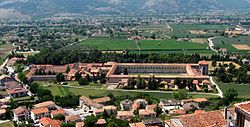Certosa di Padula
You can help expand this article with text translated from the corresponding article in Italian. (January 2023) Click [show] for important translation instructions.
|
| Certosa di Padula | |
|---|---|
 | |
| Type | Monastery |
| Location | Padula, Campania, Italy |
| Coordinates | 40°20′14″N 15°39′07″E / 40.33722°N 15.65194°E |
Europe and North America | |
Padula Charterhouse, in
The monastery is the largest in Italy. Its building history covers 450 years, but the principal parts of the buildings are in Baroque style. It is a very large monastery, comprising 51,500 m2 (12.7 acres), with 320 rooms and halls.
History
Padula Charterhouse was founded by

The monastery has the biggest
According to the strict Carthusian distinction between contemplation and work, there are two distinct places for these practices: on the one hand the peaceful cloisters, the library with its fine Vietri ceramic tiled floor, the chapels decorated with fine inlaid marble works. The altar frontals in most of the chapels are inlaid, not with marble, but with some of the most spectacular 18th. century scagliola work ever created. This is the highest concentration of such work in one place. One of the centres of production was in Naples. the cloister orchards; and on the other hand the large kitchen,[1] the cellars with their enormous wine vats, the laundries, and the huge external yards, where there were people working in the stables, ovens, stores, and at the olive oil mill. The yards were used for productive activities and for trade between the charterhouse and the external world.
The monastery also houses the archaeological museum of Western Lucania, which preserves a collection of all the finds unearthed in the excavations at the
The building has also played a role in the military history of Italy. It served as French headquarters during the
References
- ^ "More info on the legendary thousand egg omelette cooked for Charles V". Archived from the original on 2010-09-09. Retrieved 2009-10-25.
